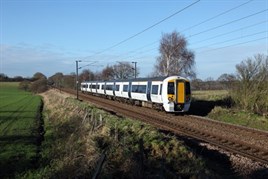Network Rail is due to issue a strategy document in late March regarding electrification. At the February 9 event, it was made clear that IPEMU would feature. Says Ambrose: “It will consider the conversion of DC to AC power, and also IP fleets.”
He tells RAIL that 31 different bids were received after the contract to convert an EMU was put out to open tender. Bombardier won that deal.
But it wasn’t just about the train, as Ambrose explains: “We had to get all the data for the train and its power demand. Batteries had to be tested in a laboratory environment. Performance testing using 379013 was carried out at Litchurch Lane, where it ran at speeds of up to 20mph on a mile-long test track. From there it was taken to Old Dalby, where it could run at speeds up to 100mph.
In the cab, it was essential that the driver didn’t see much change. Ambrose explains: “We didn’t want the driver to see anything different. It was a dual-voltage train, and instead of AC/DC it is AC/IP. It doesn’t look any different.”
Four AGA drivers are trained to drive it. All are based at Colchester, and they visited Old Dalby for training and testing. They first had to learn Class 379s on the West Anglia Main Line, as the EMUs do not run on the Great Eastern Main Line.
The route chosen was the Harwich Town-Manningtree branch. Ambrose explains why the route was selected over the Marks Tey-Sudbury line (which isn’t electrified) and the Southminster route.
“There would be little disruption to passengers and it is electrified, so if there was a problem the pantograph could be raised. The journey is a 50-minute round trip.
“We looked at an 11-mile battery run and actually have built confidence. We know it will do round trips.”
He acknowledges that problems have still been encountered: “We had problems with the Volt balance on the rafts. But even performing with only one raft, it performed the same as the targets we wanted.”
Ambrose says of the IPEMU: “We have developed it. We have proved it. It gives us IPEMU, and from that we need to develop the strategy to look at where it could be used. The Department for Transport is keenly interested in this being used for future franchises.”
Performance-wise, acceleration is 0.5 metres per second, the equivalent of a Class 153 single-car diesel multiple unit. Ambrose points out that these figures are the basics for the IPEMU and what it has been tasked with doing. He says it has met the design criteria for a Class 379, which can do 0-60mph in 51 seconds.
Costs have been mentioned, but not specific figures. Production costs for an IPEMU against an MTU power pack were deemed to be more expensive, but this was defended because the ‘upstream’ costs over the lifetime of a train would be cheaper on an IPEMU than a DMU.
Feasibility studies have also been carried out on converting older EMUs to IPEMU, which would require the trains to be fitted with new traction packs. With plans to do this on Class 317s and ‘321s’, and with work under way to do so to Class 455s, Bombardier has carried out a feasibility study into converting a ‘317’, although physical conversions have not been done.
NR does admit, however: “Any future IPEMU would most likely be designed as a new train and not an adapted unit, to minimise energy consumption. But this project will also provide useful information for retro-fit.”
Per Allmer, head of Western Europe, Middle East and Africa region at Bombardier Transportation, says: “The IPEMU demonstrates what battery technology offers the rail industry. Following extensive design and testing work, the train has now successfully begun a trial passenger service, proving the viability of the concept.
“It’s a technology we can incorporate into future new-build trains, such as our Aventra platform, and retro-fit into existing modern rail vehicles, adding value to existing fleets.”
Whatever happens, the IPEMU offers another alternative for the railway to consider, when examining how to solve the issues of capacity and electrification.
- This feature was published in RAIL 769 on March 4 2015
















Login to comment
Comments
No comments have been made yet.